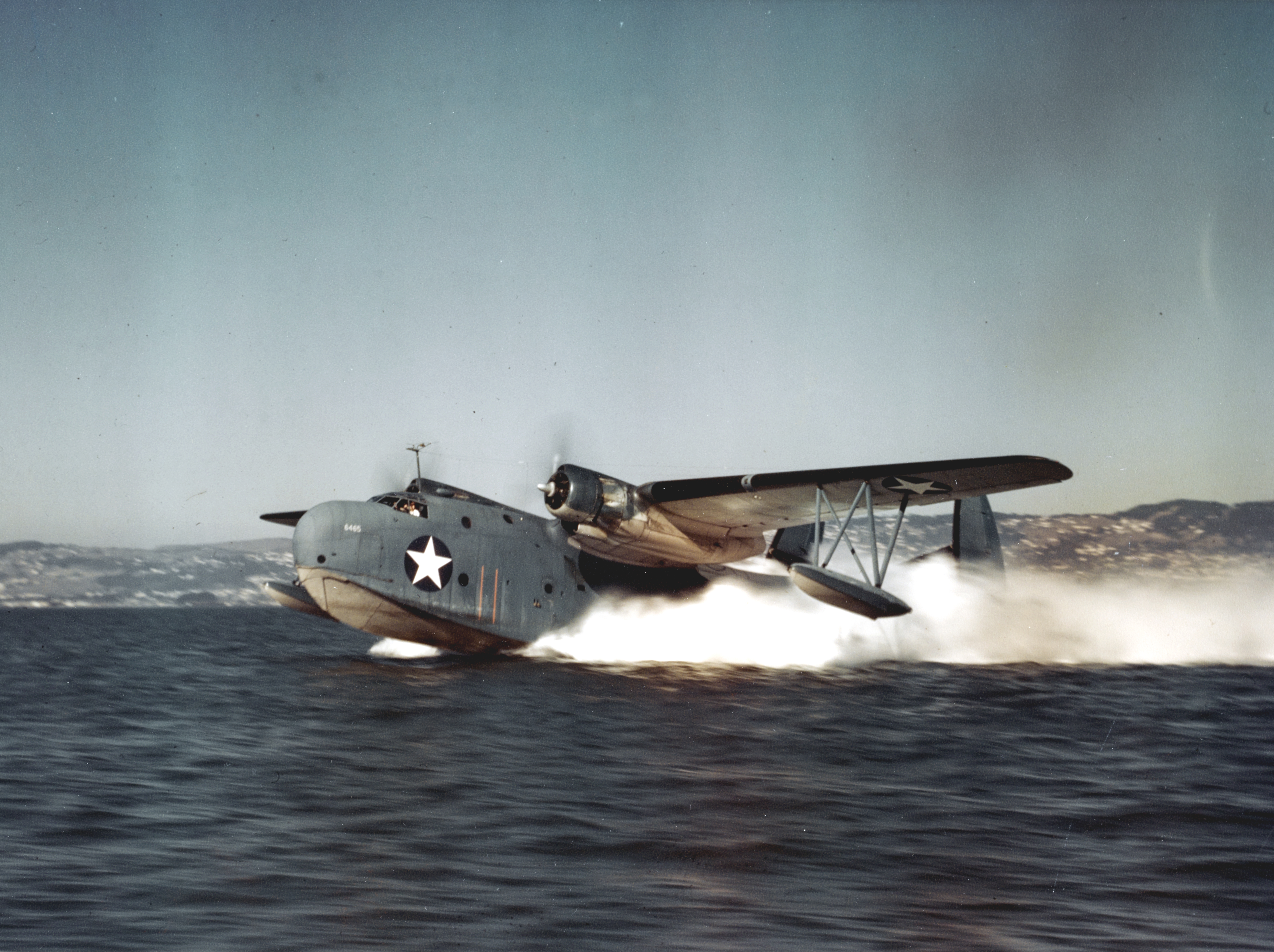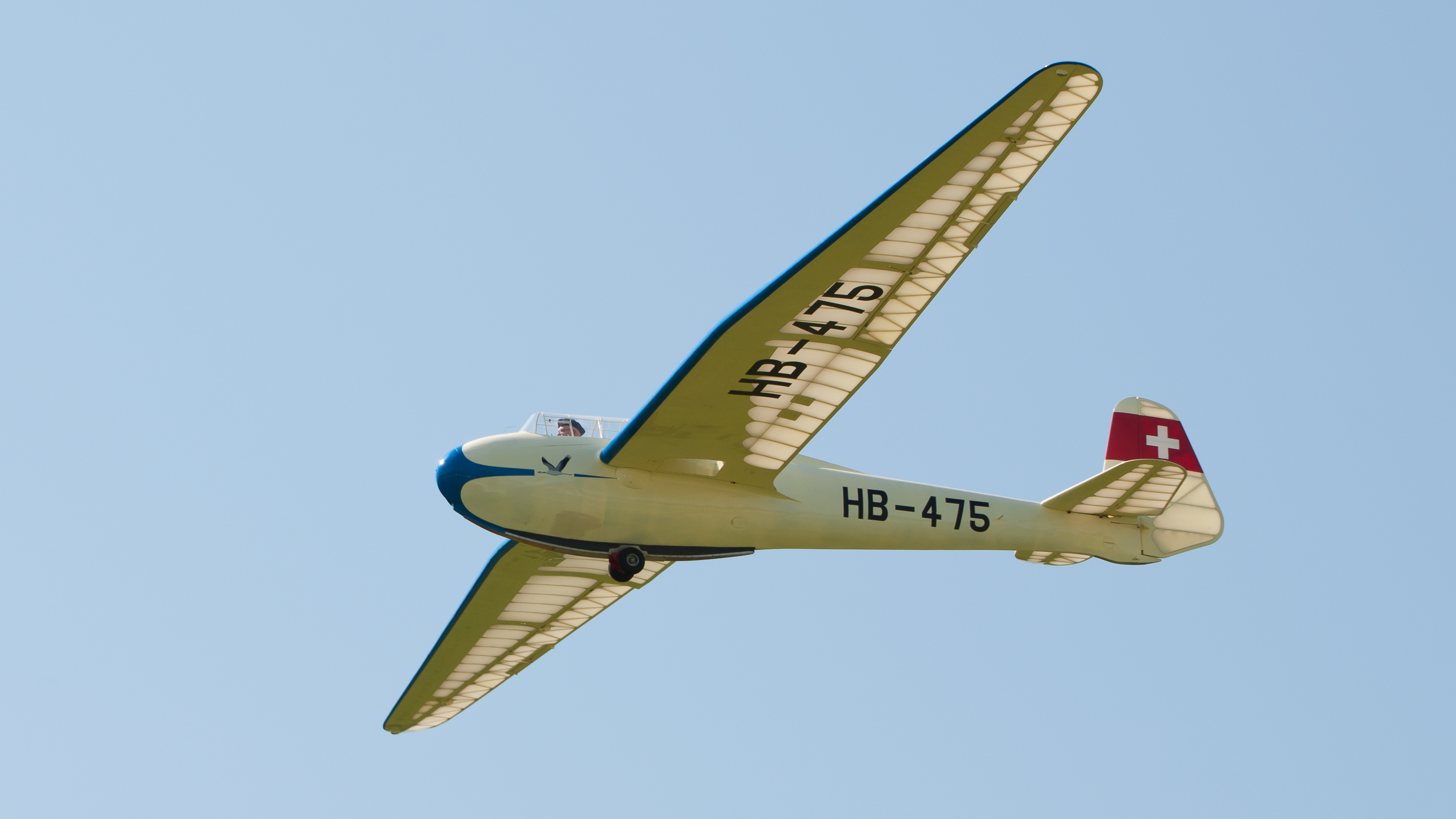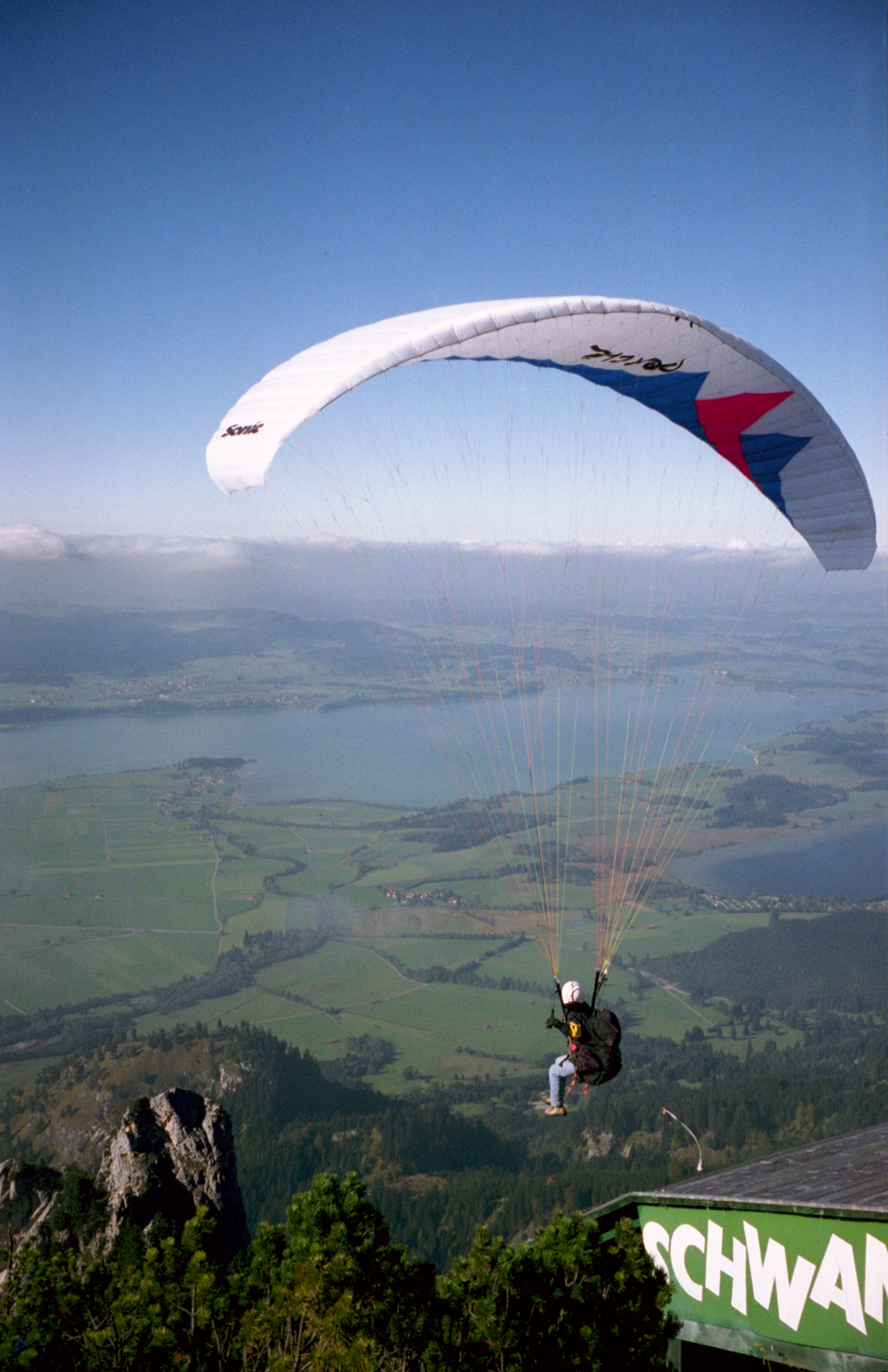|
Gull Wing
The gull wing, also known as Polish wing or Puławski wing, is an aircraft wing configuration with a prominent bend in the wing inner section towards the wing root. Its name is derived from the seabirds which it resembles and from the Polish aircraft designer Zygmunt Puławski who started using this design in his planes. Numerous aircraft have incorporated such wings for a diverse range of purposes. The gull wing was commonly used to improve visibility in a high wing arrangement, because such wing could be thinnest by the fuselage, and in theory should limit pilot's view no more than A-pillars of a windscreen in a car body. Gliders were the first aircraft to feature the gull wing, starting with the Weltensegler in 1921; it was not until the record-breaking Fafnir at the end of that decade did the configuration gain popularity. Beyond becoming popular for the next three decades amongst high-performance gliders, various ground-based aircraft and flying boats also adopted var ... [...More Info...] [...Related Items...] OR: [Wikipedia] [Google] [Baidu] |
DFS Habicht E 1
DFS may refer to: Brands and enterprises * Dancer Fitzgerald Sample, advertising agency, now Saatchi & Saatchi * DFS Furniture, a furniture retailer in the United Kingdom and Ireland * DFS Group (Duty Free Shoppers), Hong Kong * DFS Program Exchange, a former syndicator of TV programs * Discover Financial Services, NYSE symbol * Deutsche Flugsicherung, an air traffic control company Organizations * Department of Field Support, a UN department * Department of Financial Services (other) * Department of Financial Studies, University of Delhi, India * Det frivillige Skyttervesen, the National Rifle Association of Norway * Deutsche Flugsicherung, the German air traffic control organisation * Deutsche Forschungsanstalt für Segelflug (German Research Institute for Sailplane Flight) * Dirección Federal de Seguridad, Federal Direction of Security, Mexico * New York State Department of Financial Services Science and technology Computing * Depth-first search, an algorithm for ... [...More Info...] [...Related Items...] OR: [Wikipedia] [Google] [Baidu] |
PBM Mariner
The Martin PBM Mariner is a twin-engine American patrol bomber flying boat of World War II and the early Cold War era. It was designed to complement the Consolidated PBY Catalina and PB2Y Coronado in service. A total of 1,366 PBMs were built, with the first example flying on 18 February 1939, and the type entering service in September 1940, with the last of the type being retired in 1964. A Mariner, otherwise noted for its WW2 and post-War service, was the type that vanished searching for Flight 19. Flight 19 vanished in the Bermuda Triangle, it and the Mariner that searched for it were never found with its 14 crew, though it was thought to have suffered a mid-air explosion. Another noted crash was the 1946 Antarctica PBM Mariner crash in December 1946. Design and development In 1937 the Glenn L. Martin Company designed a new twin-engined flying boat, the Model 162, to succeed its earlier Martin P3M and complement the PBY Catalina and PB2Y Coronado. It received an order ... [...More Info...] [...Related Items...] OR: [Wikipedia] [Google] [Baidu] |
DFS Kranich
The DFS Kranich is a type of German Glider (sailplane), glider. It was developed by Hans Jacobs for the Deutsche Forschungsanstalt für Segelflug (DFS). History Series production of the Kranich (Crane) took place in the aircraft division of Karl Schweyer AG in Mannheim. The two-seater was, in its version 2, the most widely built two-seat glider in Germany from 1935 to 1939. Several hundred examples were built; exact numbers are not known. On 11 October 1940 Erich Klöckner in a Kranich achieved the record height in a glider of 11,460 m (37598 ft). Because it occurred in wartime, the altitude record was not recognized by the Allied occupying powers, and Klöckner only received official recognition by the Fédération Aéronautique Internationale (FAI) in the late 1990s.aerokurier magazine 1/1999: Erich Klöckners Vorstoß zur Tropopause, Motor Presse 1999 This record height was only exceeded ten years after the flight by the American Bill Ivans during a similar scientific progra ... [...More Info...] [...Related Items...] OR: [Wikipedia] [Google] [Baidu] |
DFS Habicht
The DFS ''Habicht'' (German: "Hawk") is an unlimited aerobatic sailplane that was designed in 1936 by Hans Jacobs with support provided by the Deutsche Forschungsanstalt für Segelflug. Four planes were made available for the Olympic Games of 1936, where the maneuvers of the Habicht over and literally inside the Olympic stadium enthralled spectators. The flight qualities of the Habicht were praised by pilots, including Hanna Reitsch. It participated in many airshows abroad before the war, including the 1938 National Air Races in Cleveland, Ohio.Reitsch, H., 1955, The Sky My Kingdom, London: Biddles Limited, Guildford and King's Lynn, Modified versions of the Habicht, dubbed the Stummel-Habicht ("Stumpy Hawk"), were used to train pilots to fly the Messerschmitt Me 163 Komet rocket-powered fighter. Trainees included students from the Hitler Youth Glider Schools. The Me 163 was designed to use its entire load of rocket fuel to reach combat altitude of approximately , before ret ... [...More Info...] [...Related Items...] OR: [Wikipedia] [Google] [Baidu] |
Bowlus 1-S-2100
The Bowlus 1-S-2100 Senior Albatross is a 1930s single-seat glider designed by William Hawley Bowlus for Bowlus Sailplane Company Ltd. The aircraft is based on a prototype glider the "Super Sailplane" designed by Bowlus, and instructor Martin Schempp, built by students at the Curtiss-Wright Technical Institute The Curtiss-Wright Technical Institute was an early professional trade school operated by the Curtiss-Wright corporation for aircraft maintenance training. Director Major C. C. Moseley was one of only three school directors selected across Americ .... Specifications See also References Bibliography *Coates, Andrew, ''Jane's World Sailplanes and Motorgliders''. London. Macdonald and Jane's Publishers Ltd., 1978. *Simons, Martin. ''Sailplanes 1920 - 1945'' (Volume 1). Eqip Werbung & Verlag Gmbh (2004) External links Bowlus 1-S-2100 Senior Albatross [...More Info...] [...Related Items...] OR: [Wikipedia] [Google] [Baidu] |
Magdeburg
Magdeburg (; ) is the Capital city, capital of the Germany, German States of Germany, state Saxony-Anhalt. The city is on the Elbe river. Otto I, Holy Roman Emperor, Otto I, the first Holy Roman Emperor and founder of the Archbishopric of Magdeburg, was buried in the city's Magdeburg Cathedral, cathedral after his death. Magdeburg's version of German town law, known as Magdeburg rights, spread throughout Central Europe, Central and Eastern Europe. In the Late Middle Ages, Magdeburg was one of the largest and most prosperous German cities and a notable member of the Hanseatic League. One of the most notable people from the city was Otto von Guericke, famous for his experiments with the Magdeburg hemispheres. Magdeburg has experienced three major devastations in its history. In 1207 the first catastrophe struck the city, with a fire burning down large parts of the city, including the Magdeburg Cathedral#Previous building, Ottonian cathedral. The Catholic League (German), Catholi ... [...More Info...] [...Related Items...] OR: [Wikipedia] [Google] [Baidu] |
Wasserkuppe
The Wasserkuppe (;) is the highest mountain in the Rhön Mountains, Rhön range and the tallest elevation in the Germany, German state of Hesse, standing at above sea level. It forms a prominent plateau within the Fulda district and is known as the "cradle of gliding". Great advances in sailplane development took place here during the Aviation between the World Wars, interwar period, driven by annual contests. To this day, an airfield near the summit continues to be used by gliding clubs and light aircraft pilots. Etymology The German language, German name is derived from ''Wasenkuppe, Asenberg'' or ''Weideberg'' and means ''Pasture mountain''. Geography The Wasserkuppe lies in the administrative district Fulda (district), Fulda north of Gersfeld. Other villages nearby are Poppenhausen, Hesse, Poppenhausen ( west - south west) and Wüstensachsen ( east, part of Ehrenberg, Hesse). It is part of the Rhön Biosphere Reserve. The Wasserkuppe sources the spring of the river Ful ... [...More Info...] [...Related Items...] OR: [Wikipedia] [Google] [Baidu] |
Lift-to-drag Ratio
In aerodynamics, the lift-to-drag ratio (or L/D ratio) is the Lift (force), lift generated by an aerodynamic body such as an aerofoil or aircraft, divided by the aerodynamic drag caused by moving through air. It describes the aerodynamic efficiency under given flight conditions. The L/D ratio for any given body will vary according to these flight conditions. For an aerofoil wing or powered aircraft, the L/D is specified when in straight and level flight. For a glider it determines the Lift-to-drag ratio#Glide ratio, glide ratio, of distance travelled against loss of height. The term is calculated for any particular airspeed by measuring the lift generated, then dividing by the drag at that speed. These vary with speed, so the results are typically plotted on a 2-dimensional graph. In almost all cases the graph forms a U-shape, due to the two main components of drag. The L/D may be calculated using computational fluid dynamics or computer simulation. It is measured empirically by ... [...More Info...] [...Related Items...] OR: [Wikipedia] [Google] [Baidu] |
Dihedral (aircraft)
Dihedral angle is the upward angle from horizontal of the wings or tailplane of a fixed-wing aircraft. "Anhedral angle" is the name given to negative dihedral angle, that is, when there is a ''downward'' angle from horizontal of the wings or tailplane of a fixed-wing aircraft. Dihedral angle has a strong influence on dihedral effect, which is named after it. Dihedral effect is the amount of roll moment produced in proportion to the amount of sideslip. Dihedral effect is a critical factor in the stability of an aircraft about the roll axis (the spiral mode). It is also pertinent to the nature of an aircraft's Dutch roll oscillation and to maneuverability about the roll axis. Longitudinal dihedral is a comparatively obscure term related to the pitch axis of an airplane. It is the angle between the zero-lift axis of the wing and the zero-lift axis of the horizontal tail. Longitudinal dihedral can influence the nature of controllability about the pitch axis and the ... [...More Info...] [...Related Items...] OR: [Wikipedia] [Google] [Baidu] |
Alexander Lippisch
Alexander Martin Lippisch (2 November 1894 – 11 February 1976) was a German aeronautical engineer, a pioneer of aerodynamics who made important contributions to the understanding of tailless aircraft, delta wings and the ground effect in aircraft, ground effect, and also worked in the U.S. Within the Opel-RAK program, he was the designer of the world's first rocket-powered glider. He developed and conceptualized delta wing designs which functioned practically in supersonic delta wing fighter aircraft as well as in hang gliders. People he worked with continued the development of the delta wing and supersonic flight concepts over the 20th century. His most famous designs are the Messerschmitt Me 163 rocket-powered interceptorHanna Reitsch, Reitsch, H., 1955The Sky My Kingdom London: Biddles Limited, Guildford and King's Lynn, and the Dornier Aerodyne. Early life Lippisch was born in Munich, Kingdom of Bavaria. He later recalled that his interest in aviation began with a demonst ... [...More Info...] [...Related Items...] OR: [Wikipedia] [Google] [Baidu] |
Pulley
Sheave without a rope A pulley is a wheel on an axle or shaft enabling a taut cable or belt passing over the wheel to move and change direction, or transfer power between itself and a shaft. A pulley may have a groove or grooves between flanges around its circumference to locate the cable or belt. The drive element of a pulley system can be a rope, cable, belt, or chain. History The earliest evidence of pulleys dates back to Ancient Egypt in the Twelfth Dynasty (1991–1802 BC) and Mesopotamia in the early 2nd millennium BC. In Roman Egypt, Hero of Alexandria (c. 10–70 AD) identified the pulley as one of six simple machines used to lift weights. Pulleys are assembled to form a block and tackle in order to provide mechanical advantage to apply large forces. Pulleys are also assembled as part of belt and chain drives in order to transmit power from one rotating shaft to another. Plutarch's ''Parallel Lives'' recounts a scene where Archimedes proved the effectiveness ... [...More Info...] [...Related Items...] OR: [Wikipedia] [Google] [Baidu] |
Wing Tip
A wing tip (or wingtip) is the part of the wing that is most distant from the fuselage of a fixed-wing aircraft. Because the wing tip shape influences the size and drag of the wingtip vortices, tip design has produced a diversity of shapes, including: * Squared-off * Aluminium tube bow * Rounded * Hoerner style * Winglets * Drooped tips * Raked wingtips * Tip tanks * Sails * Fences * End plates Winglets have become popular additions to high speed aircraft to increase fuel efficiency by reducing drag from wingtip vortices. In lower speed aircraft, the effect of the wingtip shape is less apparent, with only a marginal performance difference between round, square, and Hoerner style tips The slowest speed aircraft, STOL aircraft, may use wingtips to shape airflow for controllability at low airspeeds. Wing tips are also an expression of aircraft design style, so their shape may be influenced by marketing considerations as well as by aerodynamic requirements. Wing tips a ... [...More Info...] [...Related Items...] OR: [Wikipedia] [Google] [Baidu] |






